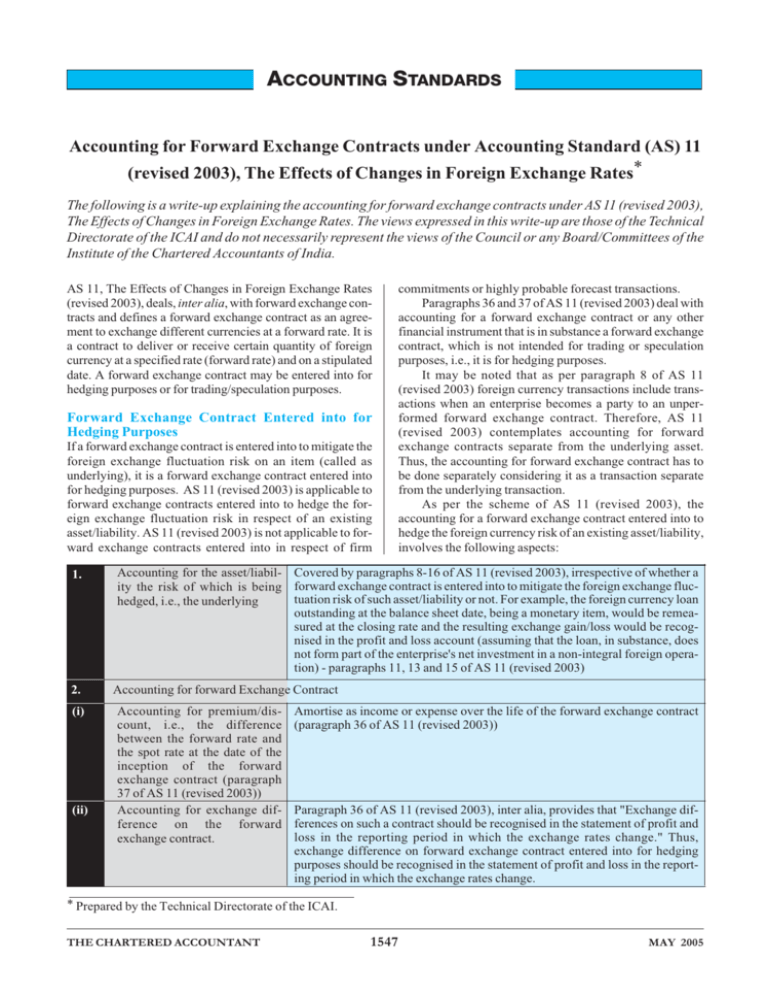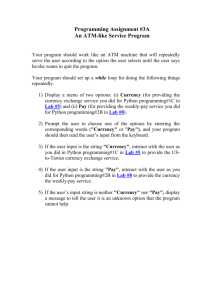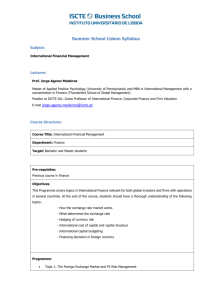Accounting for Forward Exchange Contracts under
advertisement

ACCOUNTING STANDARDS Accounting for Forward Exchange Contracts under Accounting Standard (AS) 11 (revised 2003), The Effects of Changes in Foreign Exchange Rates* The following is a write-up explaining the accounting for forward exchange contracts under AS 11 (revised 2003), The Effects of Changes in Foreign Exchange Rates. The views expressed in this write-up are those of the Technical Directorate of the ICAI and do not necessarily represent the views of the Council or any Board/Committees of the Institute of the Chartered Accountants of India. AS 11, The Effects of Changes in Foreign Exchange Rates (revised 2003), deals, inter alia, with forward exchange contracts and defines a forward exchange contract as an agreement to exchange different currencies at a forward rate. It is a contract to deliver or receive certain quantity of foreign currency at a specified rate (forward rate) and on a stipulated date. A forward exchange contract may be entered into for hedging purposes or for trading/speculation purposes. Forward Exchange Contract Entered into for Hedging Purposes If a forward exchange contract is entered into to mitigate the foreign exchange fluctuation risk on an item (called as underlying), it is a forward exchange contract entered into for hedging purposes. AS 11 (revised 2003) is applicable to forward exchange contracts entered into to hedge the foreign exchange fluctuation risk in respect of an existing asset/liability. AS 11 (revised 2003) is not applicable to forward exchange contracts entered into in respect of firm 1. 2. (i) (ii) commitments or highly probable forecast transactions. Paragraphs 36 and 37 of AS 11 (revised 2003) deal with accounting for a forward exchange contract or any other financial instrument that is in substance a forward exchange contract, which is not intended for trading or speculation purposes, i.e., it is for hedging purposes. It may be noted that as per paragraph 8 of AS 11 (revised 2003) foreign currency transactions include transactions when an enterprise becomes a party to an unperformed forward exchange contract. Therefore, AS 11 (revised 2003) contemplates accounting for forward exchange contracts separate from the underlying asset. Thus, the accounting for forward exchange contract has to be done separately considering it as a transaction separate from the underlying transaction. As per the scheme of AS 11 (revised 2003), the accounting for a forward exchange contract entered into to hedge the foreign currency risk of an existing asset/liability, involves the following aspects: Accounting for the asset/liabil- Covered by paragraphs 8-16 of AS 11 (revised 2003), irrespective of whether a ity the risk of which is being forward exchange contract is entered into to mitigate the foreign exchange fluctuation risk of such asset/liability or not. For example, the foreign currency loan hedged, i.e., the underlying outstanding at the balance sheet date, being a monetary item, would be remeasured at the closing rate and the resulting exchange gain/loss would be recognised in the profit and loss account (assuming that the loan, in substance, does not form part of the enterprise's net investment in a non-integral foreign operation) - paragraphs 11, 13 and 15 of AS 11 (revised 2003) Accounting for forward Exchange Contract Accounting for premium/discount, i.e., the difference between the forward rate and the spot rate at the date of the inception of the forward exchange contract (paragraph 37 of AS 11 (revised 2003)) Accounting for exchange difference on the forward exchange contract. Amortise as income or expense over the life of the forward exchange contract (paragraph 36 of AS 11 (revised 2003)) Paragraph 36 of AS 11 (revised 2003), inter alia, provides that "Exchange differences on such a contract should be recognised in the statement of profit and loss in the reporting period in which the exchange rates change." Thus, exchange difference on forward exchange contract entered into for hedging purposes should be recognised in the statement of profit and loss in the reporting period in which the exchange rates change. ∗ Prepared by the Technical Directorate of the ICAI. THE CHARTERED ACCOUNTANT 1547 MAY 2005 ACCOUNTING STANDARDS The application of the above principles is explained with the help of the following illustration: Illustration On 1st January, 2005, a company entered into a foreign currency transaction by taking a loan of US $ 1 Lakh. The amount of loan is required to be paid on 30th June, 2005. On 1st January 2005 itself, the company entered into a forward exchange contract for the transaction to mitigate the risks associated with changes in exchange rates. 01.01.05 31.03.05 30.06.05 Spot rate 45 Forward rate (for six months) Forward rate (for three months) 47 52 48 - - - 51 - Assuming that the accounting year of the company is the financial year, the journal entries for the above transaction are as below: (Amount in Rs. Lakhs) 01.01.2005 (i) Bank A/c Dr. 45 To Foreign Currency Loan A/c 45 (Entry passed for taking the foreign currency loan) (ii) Foreign currency receivable A/c Dr. 45 Deferred Premium A/c Dr. 3 To Amount payable to bank 48 (Entry passed for entering into forward exchange contract) 31.03.2005 (iii) Premium A/c Dr. 1.5 To Deferred Premium A/c 1.5 (Entry passed for amortisation of proportionate premium on forward exchange contract for three months) (iv) Foreign Exchange Loss A/c Dr. 2 To Foreign Currency Loan A/c 2 (Entry passed for booking exchange loss on foreign currency loan at the balance sheet date (47-45)*1 lakh) (v) Foreign currency receivable A/c Dr. 2 To Foreign exchange gain A/c 2 (Entry passed for booking of exchange gain on forward exchange contract) 30.06.2005 (vi) Premium A/c Dr. 1.5 To Deferred Premium A/c 1.5 (Entry passed for amortisation of proportionate premium on forward exchange contract for the next three months) THE CHARTERED ACCOUNTANT (viii) Foreign currency receivable A/c Dr. 5 To Foreign exchange gain A/c (Entry passed for booking of exchange gain on forward exchange contract) 5 (ix) Amount payable to bank A/c Dr. 48 To Bank A/c 48 (Entry passed for amount paid to bank for the settlement of forward exchange contract) The exchange rates (Rs. per US $) are as below: Period (vii)Foreign Exchange Loss A/c Dr. 5 To Foreign Currency Loan A/c 5 (Entry passed for booking exchange loss on foreign currency loan (52-47)*1 lakh) 1548 (x) Foreign currency received A/c Dr. 52 To Foreign currency receivable A/c 52 (Entry passed for valuing amount of foreign currency at the spot rate) (xi) Foreign Currency Loan A/c Dr. 52 To Foreign currency received A/c 52 (Entry passed for repayment of loan in foreign currency) It may be noted that on 31st March 2005, the profit & loss account would show a loss on foreign currency loan with a corresponding gain on forward exchange contract. Similar is the case on 30th June, 2005. Thus, the hedge accounting reflects the mitigating effect of the change in the value of the hedged item (foreign currency loan) and the hedging instruments (forward exchange contracts). Forward Exchange Contract Entered into for trading/speculation Purposes Paragraphs 38 and 39 of AS 11 (revised 2003) deal with forward exchange contracts intended for trading or speculation purposes. Paragraph 38 provides that gain or loss on such contracts should be computed by multiplying the foreign currency amount of the forward exchange contract by the difference between the forward rate available at the reporting date for the remaining maturity of the contract and the contracted forward rate (or the forward rate last used to measure a gain or loss on that contract for an earlier period). The gain or loss so computed should be recognised in the statement of profit and loss for the period. The premium or discount on the forward exchange contract is not recognised separately. The application of the above principles is explained with the help of the following illustration: Illustration Using the Information contained in the above illustration and assuming that there is no foreign currency loan and the forward exchange contract is entered into for speculation purposes, the following would be the journal entries: MAY 2005 ACCOUNTING STANDARDS (Amount in Rs. Lakhs) 01.01.2005 (i) Foreign Currency Receivable A/c Dr. 48 To Amount payable to bank A/c 48 (Entry passed for entering into forward exchange contract) 31.03.2005 (ii) Foreign Currency Receivable A/c Dr. 3 To Exchange Gain A/c 3 (Entry passed for marking to market of forward exchange contract (51-48)*1 Lakh) 30.06.2005 (iii) Foreign Currency Receivable A/c Dr. 1 To Exchange Gain A/c 1 (Entry passed for marking to market of forward exchange contract (52-51)*1 Lakh) (iv) Bank A/c Dr. 4 Amount payable to bank A/c Dr. 48 To Foreign currency receivable A/c 52 (Entry passed for settling the forward exchangecontract) Note: Premium/discount under the above situation is not separately accounted. Forward Exchange Contracts entered into to Hedge the Foreign Currency Risk of Firm Commitments or Highly Probable Forecast Transactions It may also be noted that ICAI, in 2004, had issued an Announcement titled ‘Applicability of Accounting Standard (AS) 11 (revised 2003), The Effects of Changes in Foreign Exchange Rates, in respect of exchange differences arising on a forward exchange contract entered into to hedge the foreign cur- rency risk of a firm commitment or a highly probable forecast transaction’. The Announcement clarifies that AS 11 (revised 2003) does not deal with the accounting of exchange differences arising on a forward exchange contract entered into to hedge the foreign currency risk of a firm commitment or a highly probable forecast transaction. It has also been separately clarified that AS 11 (revised 2003) continues to be applicable to exchange differences on all other forward exchange contracts. Therefore, AS 11 (revised 2003) is applicable to exchange differences on all forward exchange contracts including those entered into to hedge the foreign currency risk of existing assets and liabilities but is not applicable to the exchange differences arising on forward exchange contracts entered into to hedge the foreign currency risks of future transactions in respect of which firm commitments are made or which are highly probable forecast transactions. A firm commitment is a binding agreement for the exchange of a specified quantity of resources at a specified price on a specified future date or dates. A forecast transaction is an uncommitted but anticipated future transaction. To cover the forward exchange contracts entered into to hedge the foreign currency risks of future transactions in respect of which firm commitments are made or which are highly probable forecast transactions, an Indian Accounting Standard corresponding to International Accounting Standard (IAS) 39, Financial Instruments: Recognition and Measurement, is under preparation. Pending the issuance of the Indian Accounting Standard on the subject, an enterprise may follow an appropriate accounting treatment for such forward exchange contracts, for example, the relevant principles laid down in International Accounting Standard (IAS) 39, Financial Instruments: Recognition and Measurement. ■ On-Line Placement Portal www.placements-icai.org The Committee for Members in Industry is pleased to inform the members and others concerned, the hosting of an on-line Placement Portal with domain name www.placements-icai.org. The Placement Portal caters to the employment needs of the following categories of Members / Students: 1. Campus Interview Programme for newly qualified Chartered Accountants 2. All Members and 3. Semi-qualified professionals The placements-icai.org is a single window recruitment system for organisations interested in recruiting Chartered Accountants from the Institute’s vast talent pool of more than 1,30,000 members. Both the candidate and the recruiting entities can register themselves on-line. This new technology based opportunity is a unique endeavour of ICAI and is the first such placement portal launched by any professional body in India. The registration for the recruiting entities, desirous of recruiting Members and Semi-qualified candidates is absolutely free upto 30th June 2005. However, the recruiting entities shall be charged for participating in the campus interviews as per the existing practice. THE CHARTERED ACCOUNTANT 1549 MAY 2005






